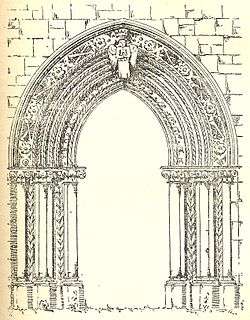Garret Moore, 1st Viscount Moore
Garret Moore, 1st Viscount Moore PC (I) (c. 1564 - 9 November 1627) was an Anglo-Irish politician and peer.
Life
Moore was the son of Sir Edward Moore of Mellifont and his wife Elizabeth Clifford (died 1581), daughter and co-heiress of Nicholas Clifford of Holme. Elizabeth had already been married three times, and all her husbands belonged to the Anglo-Irish nobility: her first husband, Sir William Brabazon, was Lord Justice of Ireland. Moore was thus the half-brother of Edward Brabazon, 1st Baron Ardee, and, through his mother's third marriage to Captain Humphrey Warren, he was also the half-brother of Sir William Warren.[1]
He was invested as a knight in 1599 by Elizabeth I. He held the office of Seneschal of Cavan in 1601. He inherited his father's very substantial estates in 1602, (much of these were leasehold, held directly from the English Crown). He was a staunch friend of Hugh O'Neill, Earl of Tyrone, and hosted the negotiations that led to the Treaty of Mellifont in 1603 and the ending of the Nine Years' War.
Moore and the Earl of Tyrone
His loyalty to the Crown was never seriously in doubt, despite his friendship with the Earl of Tyrone, but after Tyrone's flight to the Continent in 1607 he was the target of vehement attacks by his enemies, especially the volatile and unreliable Christopher St Lawrence, 10th Baron Howth, with whom he had quarreled bitterly, despite their being relatives by marriage. Howth accused Moore of treasonable dealings with Tyrone, and pressed the charges with such vigour that the Lord Lieutenant of Ireland, Sir Arthur Chichester, who had originally laughed at them as "too absurd even to charge a horse-boy with, let alone a knight", felt obliged to place Moore under house arrest. Moore admitted that on the eve of the Flight of the Earls, Tyrone had visited him at his home, Mellifont, but he firmly denied any imputation of treason. Howth, summoned before the Irish Council, refused to produce any evidence of the alleged treason, on the ground that since Moore was himself a Privy Councillor that body was clearly guilty of bias: while his bizarre claim that he had seen Moore try to raise the Devil did nothing to enhance his credibility. The case was transferred to England, and in due course Moore was cleared of all suspicion. Howth, undaunted, now accused Chichester and Moore of conspiring to murder him: the Council, which by now lost had all patience with him, ordered him to retire to his home in disgrace.
Later career
Moore was invested as a member of the Privy Council of Ireland in 1604 and served in the Irish House of Commons as the Member of Parliament for Dungannon in the Parliament of 1613-15. He held the office of Lord President of Munster in 1615. On 20 July 1616 he was created Baron Moore, of Mellefont in the County of Louth in the Peerage of Ireland. He was further honoured when he was created Viscount Moore, of Drogheda, also in the Peerage of Ireland, on 7 February 1621.[2] His principal residence was Mellifont Abbey, near Drogheda, which remained in the Moore family until 1927: it is now a ruin.
 Mellifont Abbey, c.1755
Mellifont Abbey, c.1755
Family
He married Mary Colley, daughter of Sir Henry Colley and his wife Catherine Cusack, daughter of Sir Thomas Cusack, Lord Chancellor of Ireland, by whom he had twelve children. His two eldest sons, Edward and Thomas, predeceased him: he was succeeded as Viscount by his third and eldest surviving son, Charles. His daughter Eleanor married Sir John Denham, Lord Chief Justice of Ireland, best known to history as one of the Ship Money judges: they were the parents of the distinguished poet Sir John Denham. Another daughter Anne married the prominent Royalist commander. Sir Faithful Fortescue. A third daughter Frances married Roger Jones, 1st Viscount Ranelagh, and a fourth, Jane, married Henry, 2nd Baron Blayney. Moore's grandson, Henry Moore, was created Earl of Drogheda in 1661.[3]
Moore's widow Mary remarried Charles Wilmot, 1st Viscount Wilmot: she died in 1654, and was buried beside her first husband in St. Peter's Church, Drogheda.
References
Sources
 Dunlop, Robert (1894). "Moore, Garret". In Lee, Sidney. Dictionary of National Biography. 38. London: Smith, Elder & Co.
Dunlop, Robert (1894). "Moore, Garret". In Lee, Sidney. Dictionary of National Biography. 38. London: Smith, Elder & Co. - O'Sullivan, Harold. "Moore, Garret , first Viscount Moore of Drogheda (1565/6–1627)date= 2004". Oxford Dictionary of National Biography (online ed.). Oxford University Press. doi:10.1093/ref:odnb/19110. (Subscription or UK public library membership required.)
| Peerage of Ireland | ||
|---|---|---|
| Preceded by New creation |
Viscount Moore 1621–1627 |
Succeeded by Charles Moore |
| Preceded by New creation |
Baron Moore 1616–1627 |
Succeeded by Charles Moore |